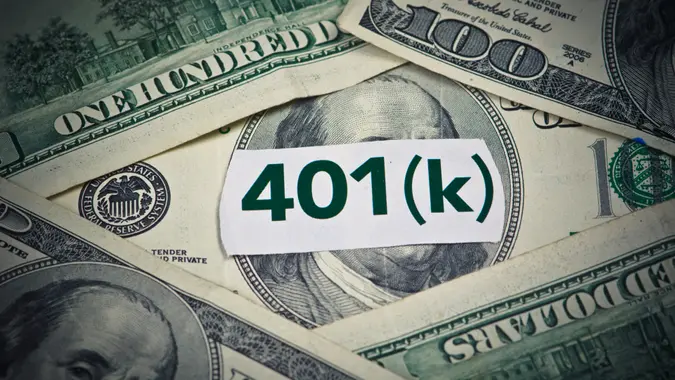What to Do With Your 401(k): Smart Moves at Every Stage

Commitment to Our Readers
GOBankingRates' editorial team is committed to bringing you unbiased reviews and information. We use data-driven methodologies to evaluate financial products and services - our reviews and ratings are not influenced by advertisers. You can read more about our editorial guidelines and our products and services review methodology.

20 Years
Helping You Live Richer

Reviewed
by Experts

Trusted by
Millions of Readers
Your 401(k) is a powerful retirement tool but knowing what to do with it — whether you’re starting, switching jobs or retiring — can make a big difference. While working you should think about retirement and increase contributions, diversify allocations and review your portfolio. If you change jobs or retire you have the choice of rolling over your 401(k), cashing out or converting it to a Roth IRA.
Think of your 401(k) as the backbone of your retirement plan — it can help you build wealth over time and safeguard the savings you’ve worked so hard to earn.
What to Do With a 401(k) While You’re Still Working
If you’re still working, your 401(k) is one of the most powerful tools you have to build wealth for retirement. But simply contributing isn’t enough — how you manage and grow your account can make a big difference over time. From maximizing your employer match to reviewing investment fees, here are a few smart steps to make the most of your 401(k) while you’re still employed.
- Contribute enough to get the full employer match. You want to contribute enough so you can take advantage of the full employer match. Typically most employers match up to 3% to 4%. After all, an employer match is essentially free money that boosts your retirement savings.
- Increase contributions each Year if possible. If you can, increase your savings rate through contributions. Remember, growth in your 401(k) compounds, and even a minor bump can lead to additional savings.
- Choose diversified investments. Aim to diversify your portfolio with different investments including stocks, bonds, ETFs and target-date funds. Choose investments that balance growth as well as risk.
- Review fees and rebalance your portfolio annually. Keep an eye on fees — even small ones can chip away at your long-term returns. Make sure to review expense ratios and rebalance your portfolio as needed to stay on track with your financial goals.
What to Do with a 401(k) When You Change Jobs
You have four options for your 401(k) plan if you change jobs:
Option 1. Leave it in your old employer’s plan. You can keep your 401(k) as is with your old employer if your old employer allows you to do so. Make note of this account so you don’t forget about it.
Option 2. Roll it over to your new employer’s 401(k). A popular option is to transfer funds from your old employer to your new employer. Typically there isn’t a fee for this kind of transfer.
Option 3. Roll it over into an IRA. If you want more choices regarding your investments, you can roll your 401(k) into an IRA. Typically an IRA offers a wider variety of investments than a 401(k).
Option 4. Cash it out. For immediate access to your 401(k) funds, you could cash out. However, if you’re younger than 59½, expect to pay a 10% penalty and income tax on the funds that you withdraw.
What to Do With a 401(k) When You Retire
Once you retire, your 401(k) turns from a savings vehicle into a source of income. But deciding what to do with that money requires careful planning. You’ll need to balance taxes, required minimum distributions (RMDs), and your long-term financial goals. Whether you leave the funds in your current plan, roll them into an IRA, or start taking withdrawals, here are the main options to consider for managing your 401(k) in retirement.
- Leave it where it is and take the required minimum distributions (RMDs). You can leave your 401(k) alone and take the RMDs starting at age 73. However, keeping it in your 401(k) may offer limited investments compared to an IRA.
- Roll it over into an IRA for more flexibility. You can roll your 401(k) into an IRA – this will allow you to manage the account more easily and gives you more choices for investment options. Unless it is a Roth IRA, you still have to take your minimum RMDs.
- Start making withdrawals to cover retirement expenses. If you’re eligible, you can start making withdrawals from your 401(k). You can use these funds to pay for retirement expenses. However, you will have to pay taxes on your withdrawals.
- Convert part of it to a Roth IRA. If you want to postpone taking all of your RMDs, you can convert part of it to a Roth IRA. However, you will pay taxes on the conversion so make certain to be aware of your tax bracket.
Should You Roll Over Your 401(k)?
Whether or not to roll over your 401(k) is a personal decision that depends on your financial goals, preferences, and the options available in your current or new plan. Many financial advisors recommend a rollover because it can give you greater control and more investment choices. But sticking with your 401(k) may make sense if you prefer simplicity and low maintenance.
When weighing your options, consider the following:
- Compare fees, investment choices, and flexibility. IRAs typically offer a wider range of investments — including CDs, ETFs, mutual funds, and bonds — and may come with lower fees than an employer-sponsored plan. However, 401(k)s can have institutional funds with lower expense ratios, so compare carefully.
- Understand the level of control you want. With an IRA, you decide where and how to invest, rather than being limited to your employer’s plan menu. That flexibility can be an advantage if you’re comfortable managing your portfolio or working with a financial advisor.
- Check your new employer’s plan first. If you’re considering rolling your old 401(k) into a new employer’s plan, review its fees and investment options. Some plans are better than others — and in some cases, staying with your old plan or moving to an IRA may be the smarter choice.
- Use a direct rollover to avoid taxes. Always choose a direct rollover, where the funds move straight from one account to another. If you receive a check made out to you, taxes may be withheld and you could face penalties if not redeposited quickly.
Strategies to Maximize Your 401(k)
Building a healthy 401(k) balance isn’t just about contributing regularly — it’s about making smart, consistent choices over time. By setting up automatic increases, choosing the right mix of investments, and resisting emotional reactions during market swings, you can help your retirement savings grow steadily and weather market ups and downs.
Here are a few practical strategies to get the most from your 401(k).
- Set automatic contribution increases. You can automate an increase in your contributions. Even a 1% to 2% can grow your retirement savings substantially.
- Use a target-date fund if unsure how to invest. A target-date fund will adjust your stock/bond mix as you move closer to retirement, allowing you to take a hands-off approach.
- Review performance once or twice a year. Make sure you review the performance of the funds a few times a year. Review your allocations and adjust accordingly.
- Avoid making emotional investment decisions during market dips. Don’t make an irrational decision when the market faces an economic downturn. Typically, when the market dips, investors may want to sell off certain stocks. A good rule of thumb is to let the dip run its course instead of panic selling your assets.
401(k) Options at Different Life Stages
Your 401(k) strategy shouldn’t stay the same throughout your career. As your income, risk tolerance, and retirement timeline evolve, your approach should too. Knowing how to adjust your contributions and investments at each stage of life can help you make the most of your retirement savings.
| Life stage | 401(k) strategy |
|---|---|
| Early career | Contribute as much as you can and take full advantage of your employer match. Focus on building consistent saving habits and investing for growth. |
| Mid-career | Increase your savings rate as your income grows. Diversify your portfolio to balance risk and potential returns. |
| Nearing retirement | Gradually shift toward more conservative investments to protect your nest egg. Start planning when and how to take withdrawals. |
| In retirement | Manage your withdrawals strategically to minimize taxes and ensure your savings last. Remember to take required minimum distributions (RMDs) starting at age 73. |
The Bottom Line
Your 401(k) can be one of the most powerful tools for securing your financial future — but it works best when you stay engaged. Whether you’re just starting out, in your peak earning years, or already retired, regularly reviewing your contributions, investments, and fees can help you stay on track. A few intentional moves today can make a meaningful difference in the lifestyle you’ll enjoy tomorrow.
FAQ
- Can I move my 401(k) to an IRA without penalties?
- Yes — if you do a direct rollover from your 401(k) to a traditional or Roth IRA, you won’t face early withdrawal penalties. Just be sure the transfer goes directly from one account to the other to avoid tax withholding.
- What happens to my 401(k) if I leave my job?
- You typically have four options: leave the money in your old plan, roll it into your new employer’s 401(k), move it to an IRA, or cash it out. Rolling it over or leaving it invested keeps your savings growing tax-deferred, while cashing out can trigger taxes and penalties.
- Can I take money out early from my 401(k)?
- You can, but you’ll usually owe a 10% early withdrawal penalty plus income taxes on the amount you take out. Exceptions exist for situations such as disability, major medical expenses, or certain hardship withdrawals.
- How do I find old 401(k) accounts?
- Start by contacting your former employer’s HR or benefits department. You can also use the National Registry of Unclaimed Retirement Benefits or search the Department of Labor’s Form 5500 database to locate old accounts.
- Should I use a financial advisor to manage my 401(k)?
- That depends on your comfort level. If you prefer a hands-on approach, you can manage it yourself using target-date funds or robo-advisors. If you want personalized guidance, a financial advisor can help you optimize investments, rebalance your portfolio, and plan for retirement income.
 Written by
Written by  Edited by
Edited by 

























